Project Portfolio Management Analysis of Reliance Industries
VerifiedAdded on 2023/01/16
|13
|2665
|64
Report
AI Summary
This report provides a comprehensive analysis of project portfolio management (PPM) within Reliance Industries Limited (RIL). It begins by establishing the context, examining RIL's perspective on PPM given its size and project needs, and evaluating its current project management practices. The report then explores opportunities and threats associated with introducing PPM, including potential successes and challenges. A key focus is the incorporation of sustainability criteria into RIL's business decision-making, covering social equity, economic efficiency, and environmental performance. The analysis culminates in the development of a plan, including key elements impacting strategic goals, a proposed portfolio management model (Modern Portfolio Theory model) with justification, and a discussion of tools and techniques. The report underscores the strategic importance of PPM for RIL's continued growth and sustainability in a global market.
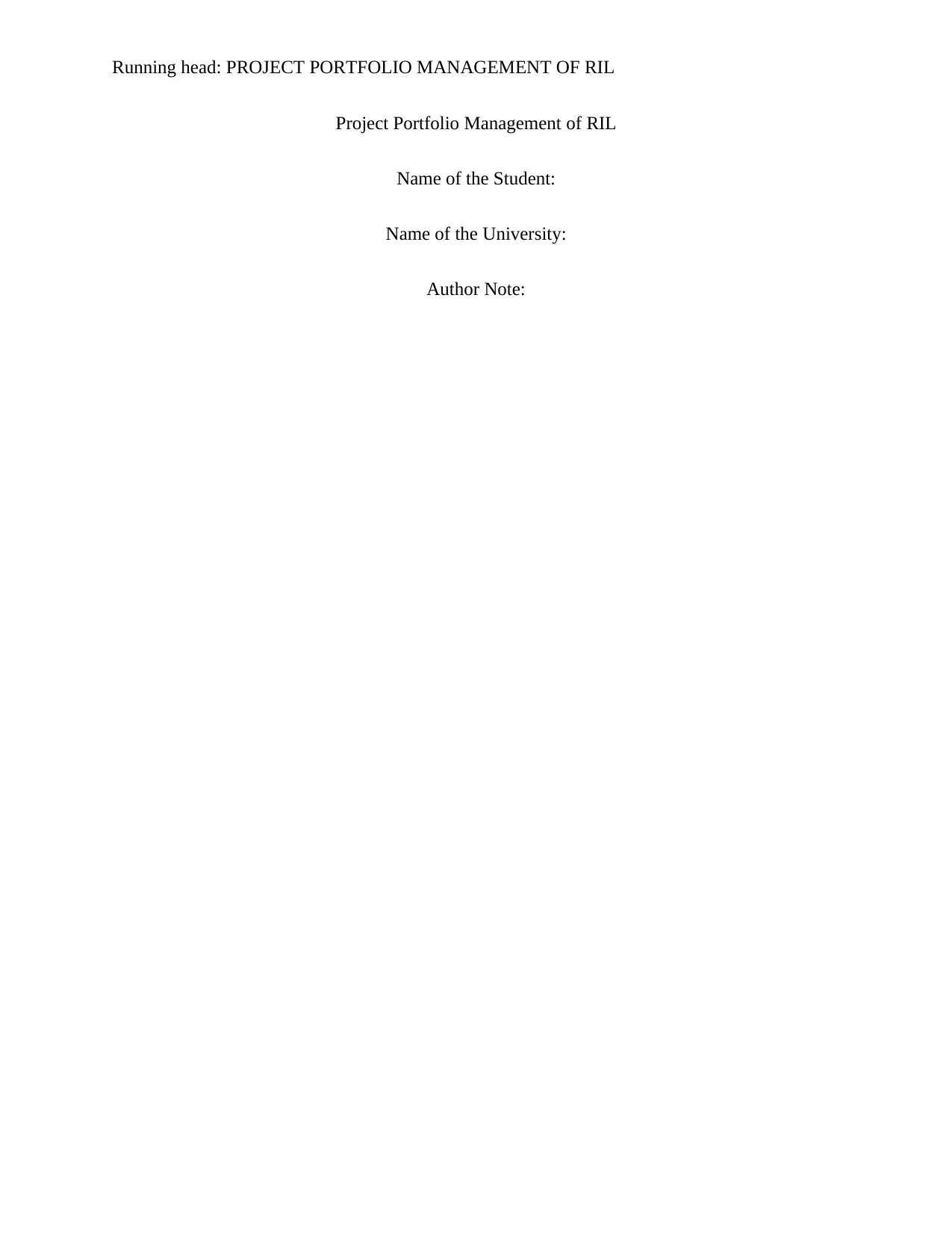
Running head: PROJECT PORTFOLIO MANAGEMENT OF RIL
Project Portfolio Management of RIL
Name of the Student:
Name of the University:
Author Note:
Project Portfolio Management of RIL
Name of the Student:
Name of the University:
Author Note:
Paraphrase This Document
Need a fresh take? Get an instant paraphrase of this document with our AI Paraphraser
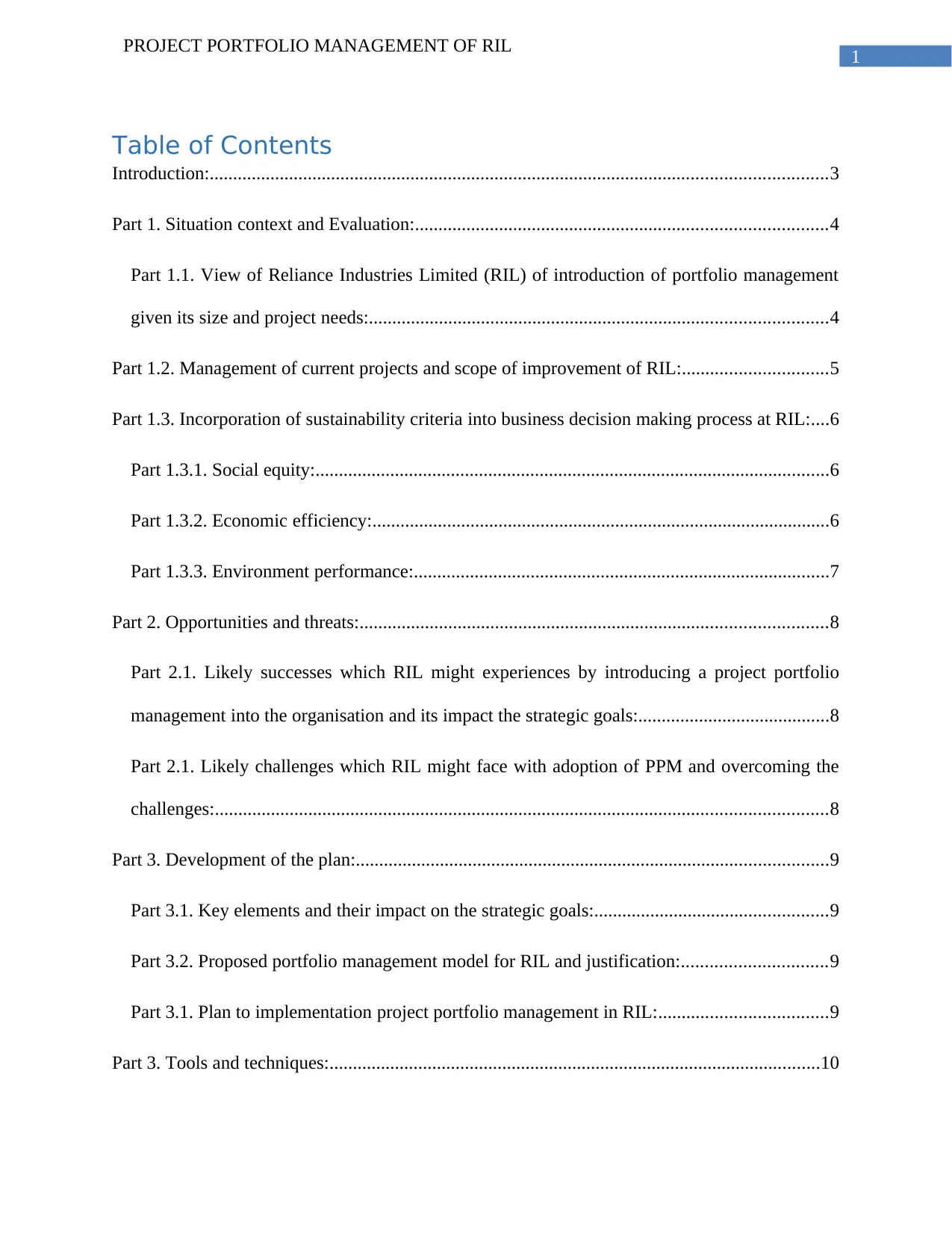
1
PROJECT PORTFOLIO MANAGEMENT OF RIL
Table of Contents
Introduction:....................................................................................................................................3
Part 1. Situation context and Evaluation:........................................................................................4
Part 1.1. View of Reliance Industries Limited (RIL) of introduction of portfolio management
given its size and project needs:..................................................................................................4
Part 1.2. Management of current projects and scope of improvement of RIL:...............................5
Part 1.3. Incorporation of sustainability criteria into business decision making process at RIL:....6
Part 1.3.1. Social equity:..............................................................................................................6
Part 1.3.2. Economic efficiency:..................................................................................................6
Part 1.3.3. Environment performance:.........................................................................................7
Part 2. Opportunities and threats:....................................................................................................8
Part 2.1. Likely successes which RIL might experiences by introducing a project portfolio
management into the organisation and its impact the strategic goals:.........................................8
Part 2.1. Likely challenges which RIL might face with adoption of PPM and overcoming the
challenges:...................................................................................................................................8
Part 3. Development of the plan:.....................................................................................................9
Part 3.1. Key elements and their impact on the strategic goals:..................................................9
Part 3.2. Proposed portfolio management model for RIL and justification:...............................9
Part 3.1. Plan to implementation project portfolio management in RIL:....................................9
Part 3. Tools and techniques:.........................................................................................................10
PROJECT PORTFOLIO MANAGEMENT OF RIL
Table of Contents
Introduction:....................................................................................................................................3
Part 1. Situation context and Evaluation:........................................................................................4
Part 1.1. View of Reliance Industries Limited (RIL) of introduction of portfolio management
given its size and project needs:..................................................................................................4
Part 1.2. Management of current projects and scope of improvement of RIL:...............................5
Part 1.3. Incorporation of sustainability criteria into business decision making process at RIL:....6
Part 1.3.1. Social equity:..............................................................................................................6
Part 1.3.2. Economic efficiency:..................................................................................................6
Part 1.3.3. Environment performance:.........................................................................................7
Part 2. Opportunities and threats:....................................................................................................8
Part 2.1. Likely successes which RIL might experiences by introducing a project portfolio
management into the organisation and its impact the strategic goals:.........................................8
Part 2.1. Likely challenges which RIL might face with adoption of PPM and overcoming the
challenges:...................................................................................................................................8
Part 3. Development of the plan:.....................................................................................................9
Part 3.1. Key elements and their impact on the strategic goals:..................................................9
Part 3.2. Proposed portfolio management model for RIL and justification:...............................9
Part 3.1. Plan to implementation project portfolio management in RIL:....................................9
Part 3. Tools and techniques:.........................................................................................................10
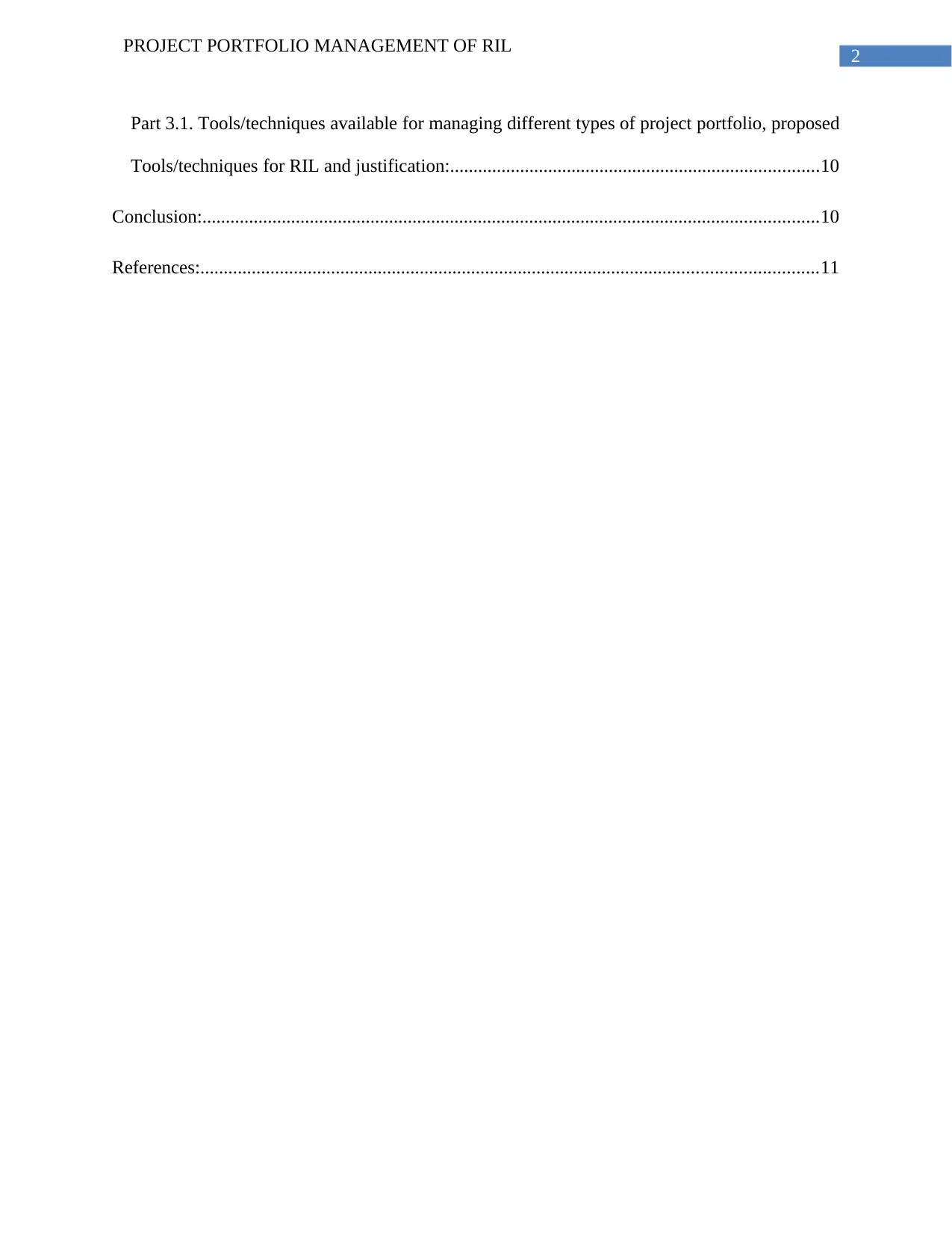
2
PROJECT PORTFOLIO MANAGEMENT OF RIL
Part 3.1. Tools/techniques available for managing different types of project portfolio, proposed
Tools/techniques for RIL and justification:...............................................................................10
Conclusion:....................................................................................................................................10
References:....................................................................................................................................11
PROJECT PORTFOLIO MANAGEMENT OF RIL
Part 3.1. Tools/techniques available for managing different types of project portfolio, proposed
Tools/techniques for RIL and justification:...............................................................................10
Conclusion:....................................................................................................................................10
References:....................................................................................................................................11
⊘ This is a preview!⊘
Do you want full access?
Subscribe today to unlock all pages.

Trusted by 1+ million students worldwide
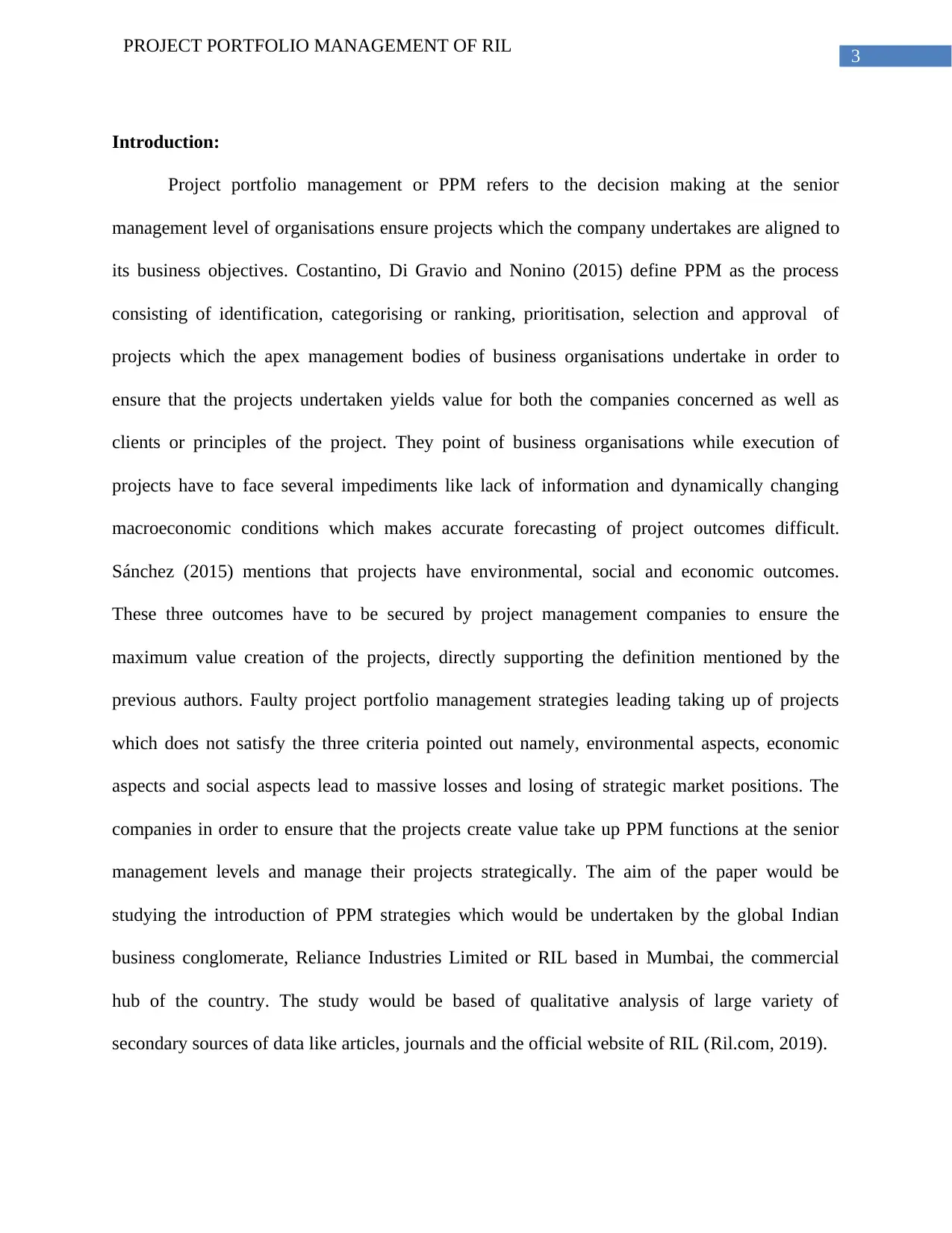
3
PROJECT PORTFOLIO MANAGEMENT OF RIL
Introduction:
Project portfolio management or PPM refers to the decision making at the senior
management level of organisations ensure projects which the company undertakes are aligned to
its business objectives. Costantino, Di Gravio and Nonino (2015) define PPM as the process
consisting of identification, categorising or ranking, prioritisation, selection and approval of
projects which the apex management bodies of business organisations undertake in order to
ensure that the projects undertaken yields value for both the companies concerned as well as
clients or principles of the project. They point of business organisations while execution of
projects have to face several impediments like lack of information and dynamically changing
macroeconomic conditions which makes accurate forecasting of project outcomes difficult.
Sánchez (2015) mentions that projects have environmental, social and economic outcomes.
These three outcomes have to be secured by project management companies to ensure the
maximum value creation of the projects, directly supporting the definition mentioned by the
previous authors. Faulty project portfolio management strategies leading taking up of projects
which does not satisfy the three criteria pointed out namely, environmental aspects, economic
aspects and social aspects lead to massive losses and losing of strategic market positions. The
companies in order to ensure that the projects create value take up PPM functions at the senior
management levels and manage their projects strategically. The aim of the paper would be
studying the introduction of PPM strategies which would be undertaken by the global Indian
business conglomerate, Reliance Industries Limited or RIL based in Mumbai, the commercial
hub of the country. The study would be based of qualitative analysis of large variety of
secondary sources of data like articles, journals and the official website of RIL (Ril.com, 2019).
PROJECT PORTFOLIO MANAGEMENT OF RIL
Introduction:
Project portfolio management or PPM refers to the decision making at the senior
management level of organisations ensure projects which the company undertakes are aligned to
its business objectives. Costantino, Di Gravio and Nonino (2015) define PPM as the process
consisting of identification, categorising or ranking, prioritisation, selection and approval of
projects which the apex management bodies of business organisations undertake in order to
ensure that the projects undertaken yields value for both the companies concerned as well as
clients or principles of the project. They point of business organisations while execution of
projects have to face several impediments like lack of information and dynamically changing
macroeconomic conditions which makes accurate forecasting of project outcomes difficult.
Sánchez (2015) mentions that projects have environmental, social and economic outcomes.
These three outcomes have to be secured by project management companies to ensure the
maximum value creation of the projects, directly supporting the definition mentioned by the
previous authors. Faulty project portfolio management strategies leading taking up of projects
which does not satisfy the three criteria pointed out namely, environmental aspects, economic
aspects and social aspects lead to massive losses and losing of strategic market positions. The
companies in order to ensure that the projects create value take up PPM functions at the senior
management levels and manage their projects strategically. The aim of the paper would be
studying the introduction of PPM strategies which would be undertaken by the global Indian
business conglomerate, Reliance Industries Limited or RIL based in Mumbai, the commercial
hub of the country. The study would be based of qualitative analysis of large variety of
secondary sources of data like articles, journals and the official website of RIL (Ril.com, 2019).
Paraphrase This Document
Need a fresh take? Get an instant paraphrase of this document with our AI Paraphraser
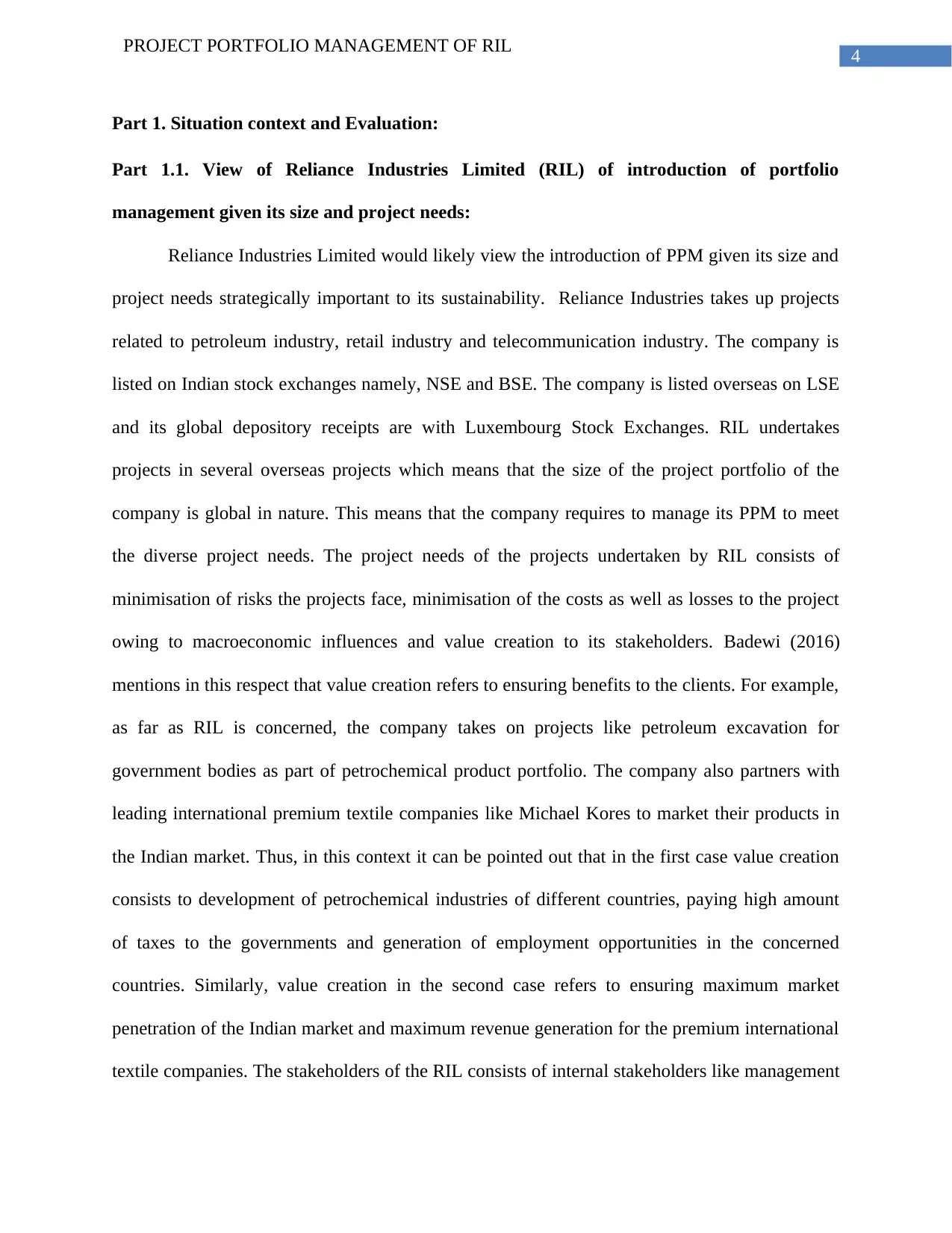
4
PROJECT PORTFOLIO MANAGEMENT OF RIL
Part 1. Situation context and Evaluation:
Part 1.1. View of Reliance Industries Limited (RIL) of introduction of portfolio
management given its size and project needs:
Reliance Industries Limited would likely view the introduction of PPM given its size and
project needs strategically important to its sustainability. Reliance Industries takes up projects
related to petroleum industry, retail industry and telecommunication industry. The company is
listed on Indian stock exchanges namely, NSE and BSE. The company is listed overseas on LSE
and its global depository receipts are with Luxembourg Stock Exchanges. RIL undertakes
projects in several overseas projects which means that the size of the project portfolio of the
company is global in nature. This means that the company requires to manage its PPM to meet
the diverse project needs. The project needs of the projects undertaken by RIL consists of
minimisation of risks the projects face, minimisation of the costs as well as losses to the project
owing to macroeconomic influences and value creation to its stakeholders. Badewi (2016)
mentions in this respect that value creation refers to ensuring benefits to the clients. For example,
as far as RIL is concerned, the company takes on projects like petroleum excavation for
government bodies as part of petrochemical product portfolio. The company also partners with
leading international premium textile companies like Michael Kores to market their products in
the Indian market. Thus, in this context it can be pointed out that in the first case value creation
consists to development of petrochemical industries of different countries, paying high amount
of taxes to the governments and generation of employment opportunities in the concerned
countries. Similarly, value creation in the second case refers to ensuring maximum market
penetration of the Indian market and maximum revenue generation for the premium international
textile companies. The stakeholders of the RIL consists of internal stakeholders like management
PROJECT PORTFOLIO MANAGEMENT OF RIL
Part 1. Situation context and Evaluation:
Part 1.1. View of Reliance Industries Limited (RIL) of introduction of portfolio
management given its size and project needs:
Reliance Industries Limited would likely view the introduction of PPM given its size and
project needs strategically important to its sustainability. Reliance Industries takes up projects
related to petroleum industry, retail industry and telecommunication industry. The company is
listed on Indian stock exchanges namely, NSE and BSE. The company is listed overseas on LSE
and its global depository receipts are with Luxembourg Stock Exchanges. RIL undertakes
projects in several overseas projects which means that the size of the project portfolio of the
company is global in nature. This means that the company requires to manage its PPM to meet
the diverse project needs. The project needs of the projects undertaken by RIL consists of
minimisation of risks the projects face, minimisation of the costs as well as losses to the project
owing to macroeconomic influences and value creation to its stakeholders. Badewi (2016)
mentions in this respect that value creation refers to ensuring benefits to the clients. For example,
as far as RIL is concerned, the company takes on projects like petroleum excavation for
government bodies as part of petrochemical product portfolio. The company also partners with
leading international premium textile companies like Michael Kores to market their products in
the Indian market. Thus, in this context it can be pointed out that in the first case value creation
consists to development of petrochemical industries of different countries, paying high amount
of taxes to the governments and generation of employment opportunities in the concerned
countries. Similarly, value creation in the second case refers to ensuring maximum market
penetration of the Indian market and maximum revenue generation for the premium international
textile companies. The stakeholders of the RIL consists of internal stakeholders like management
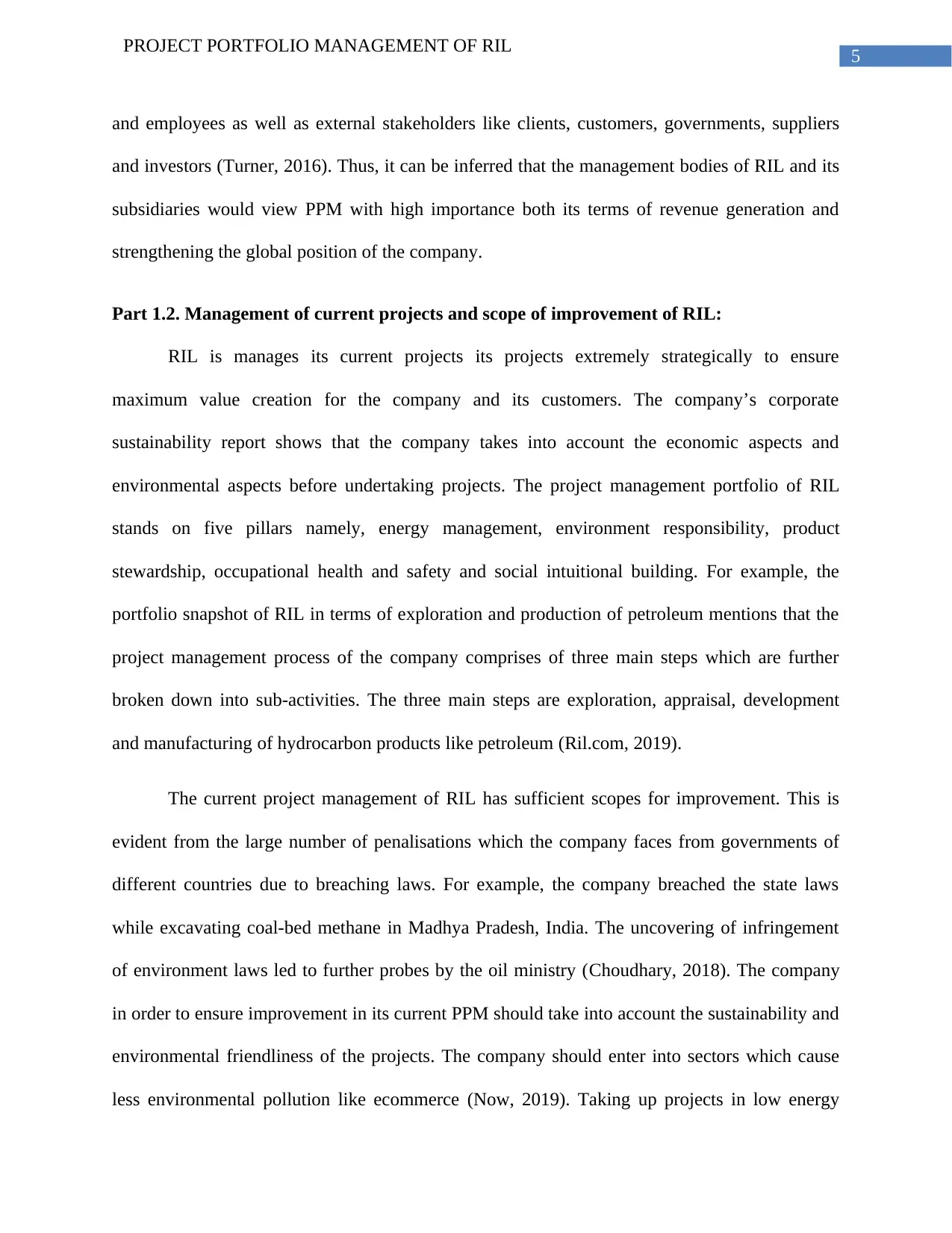
5
PROJECT PORTFOLIO MANAGEMENT OF RIL
and employees as well as external stakeholders like clients, customers, governments, suppliers
and investors (Turner, 2016). Thus, it can be inferred that the management bodies of RIL and its
subsidiaries would view PPM with high importance both its terms of revenue generation and
strengthening the global position of the company.
Part 1.2. Management of current projects and scope of improvement of RIL:
RIL is manages its current projects its projects extremely strategically to ensure
maximum value creation for the company and its customers. The company’s corporate
sustainability report shows that the company takes into account the economic aspects and
environmental aspects before undertaking projects. The project management portfolio of RIL
stands on five pillars namely, energy management, environment responsibility, product
stewardship, occupational health and safety and social intuitional building. For example, the
portfolio snapshot of RIL in terms of exploration and production of petroleum mentions that the
project management process of the company comprises of three main steps which are further
broken down into sub-activities. The three main steps are exploration, appraisal, development
and manufacturing of hydrocarbon products like petroleum (Ril.com, 2019).
The current project management of RIL has sufficient scopes for improvement. This is
evident from the large number of penalisations which the company faces from governments of
different countries due to breaching laws. For example, the company breached the state laws
while excavating coal-bed methane in Madhya Pradesh, India. The uncovering of infringement
of environment laws led to further probes by the oil ministry (Choudhary, 2018). The company
in order to ensure improvement in its current PPM should take into account the sustainability and
environmental friendliness of the projects. The company should enter into sectors which cause
less environmental pollution like ecommerce (Now, 2019). Taking up projects in low energy
PROJECT PORTFOLIO MANAGEMENT OF RIL
and employees as well as external stakeholders like clients, customers, governments, suppliers
and investors (Turner, 2016). Thus, it can be inferred that the management bodies of RIL and its
subsidiaries would view PPM with high importance both its terms of revenue generation and
strengthening the global position of the company.
Part 1.2. Management of current projects and scope of improvement of RIL:
RIL is manages its current projects its projects extremely strategically to ensure
maximum value creation for the company and its customers. The company’s corporate
sustainability report shows that the company takes into account the economic aspects and
environmental aspects before undertaking projects. The project management portfolio of RIL
stands on five pillars namely, energy management, environment responsibility, product
stewardship, occupational health and safety and social intuitional building. For example, the
portfolio snapshot of RIL in terms of exploration and production of petroleum mentions that the
project management process of the company comprises of three main steps which are further
broken down into sub-activities. The three main steps are exploration, appraisal, development
and manufacturing of hydrocarbon products like petroleum (Ril.com, 2019).
The current project management of RIL has sufficient scopes for improvement. This is
evident from the large number of penalisations which the company faces from governments of
different countries due to breaching laws. For example, the company breached the state laws
while excavating coal-bed methane in Madhya Pradesh, India. The uncovering of infringement
of environment laws led to further probes by the oil ministry (Choudhary, 2018). The company
in order to ensure improvement in its current PPM should take into account the sustainability and
environmental friendliness of the projects. The company should enter into sectors which cause
less environmental pollution like ecommerce (Now, 2019). Taking up projects in low energy
⊘ This is a preview!⊘
Do you want full access?
Subscribe today to unlock all pages.

Trusted by 1+ million students worldwide
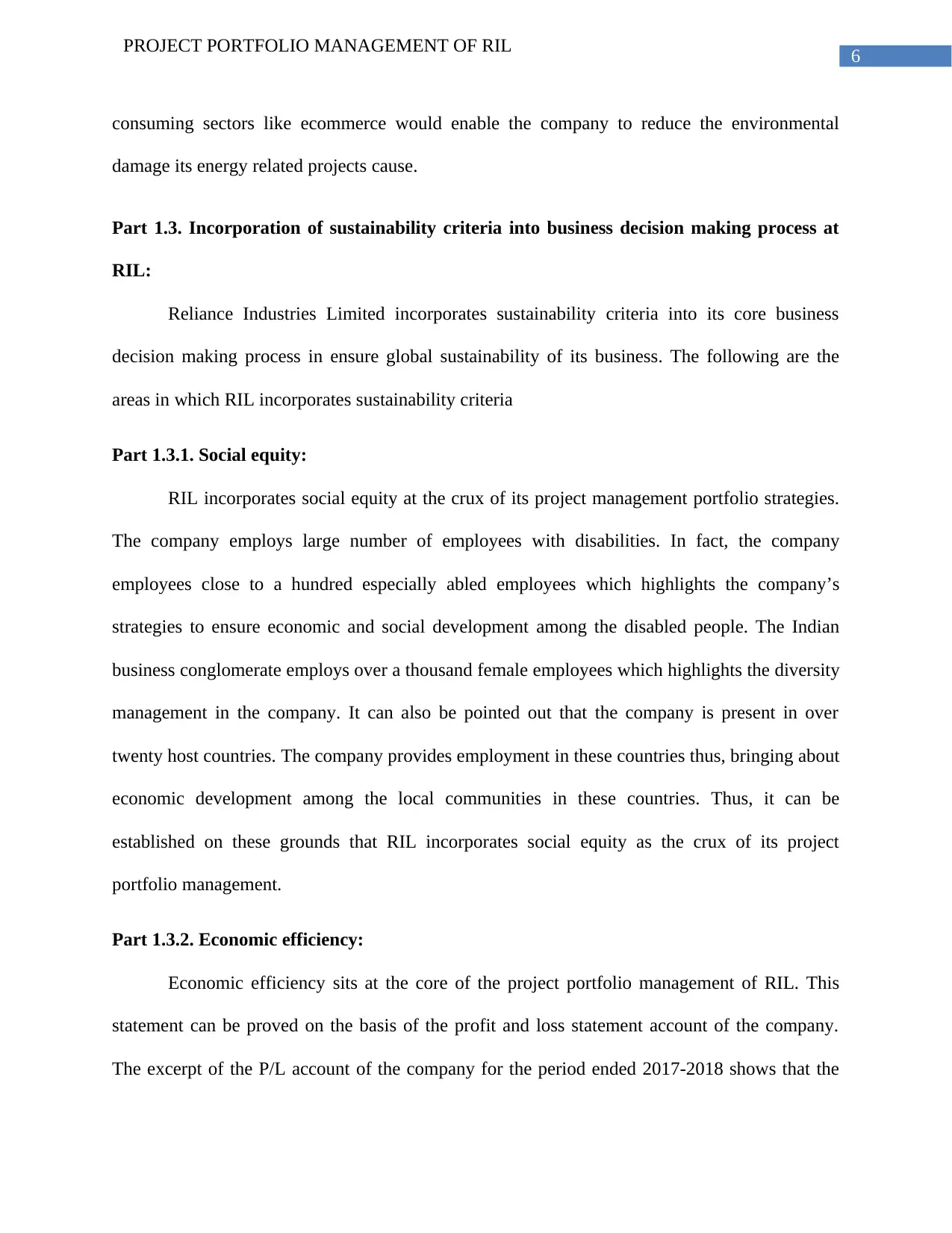
6
PROJECT PORTFOLIO MANAGEMENT OF RIL
consuming sectors like ecommerce would enable the company to reduce the environmental
damage its energy related projects cause.
Part 1.3. Incorporation of sustainability criteria into business decision making process at
RIL:
Reliance Industries Limited incorporates sustainability criteria into its core business
decision making process in ensure global sustainability of its business. The following are the
areas in which RIL incorporates sustainability criteria
Part 1.3.1. Social equity:
RIL incorporates social equity at the crux of its project management portfolio strategies.
The company employs large number of employees with disabilities. In fact, the company
employees close to a hundred especially abled employees which highlights the company’s
strategies to ensure economic and social development among the disabled people. The Indian
business conglomerate employs over a thousand female employees which highlights the diversity
management in the company. It can also be pointed out that the company is present in over
twenty host countries. The company provides employment in these countries thus, bringing about
economic development among the local communities in these countries. Thus, it can be
established on these grounds that RIL incorporates social equity as the crux of its project
portfolio management.
Part 1.3.2. Economic efficiency:
Economic efficiency sits at the core of the project portfolio management of RIL. This
statement can be proved on the basis of the profit and loss statement account of the company.
The excerpt of the P/L account of the company for the period ended 2017-2018 shows that the
PROJECT PORTFOLIO MANAGEMENT OF RIL
consuming sectors like ecommerce would enable the company to reduce the environmental
damage its energy related projects cause.
Part 1.3. Incorporation of sustainability criteria into business decision making process at
RIL:
Reliance Industries Limited incorporates sustainability criteria into its core business
decision making process in ensure global sustainability of its business. The following are the
areas in which RIL incorporates sustainability criteria
Part 1.3.1. Social equity:
RIL incorporates social equity at the crux of its project management portfolio strategies.
The company employs large number of employees with disabilities. In fact, the company
employees close to a hundred especially abled employees which highlights the company’s
strategies to ensure economic and social development among the disabled people. The Indian
business conglomerate employs over a thousand female employees which highlights the diversity
management in the company. It can also be pointed out that the company is present in over
twenty host countries. The company provides employment in these countries thus, bringing about
economic development among the local communities in these countries. Thus, it can be
established on these grounds that RIL incorporates social equity as the crux of its project
portfolio management.
Part 1.3.2. Economic efficiency:
Economic efficiency sits at the core of the project portfolio management of RIL. This
statement can be proved on the basis of the profit and loss statement account of the company.
The excerpt of the P/L account of the company for the period ended 2017-2018 shows that the
Paraphrase This Document
Need a fresh take? Get an instant paraphrase of this document with our AI Paraphraser
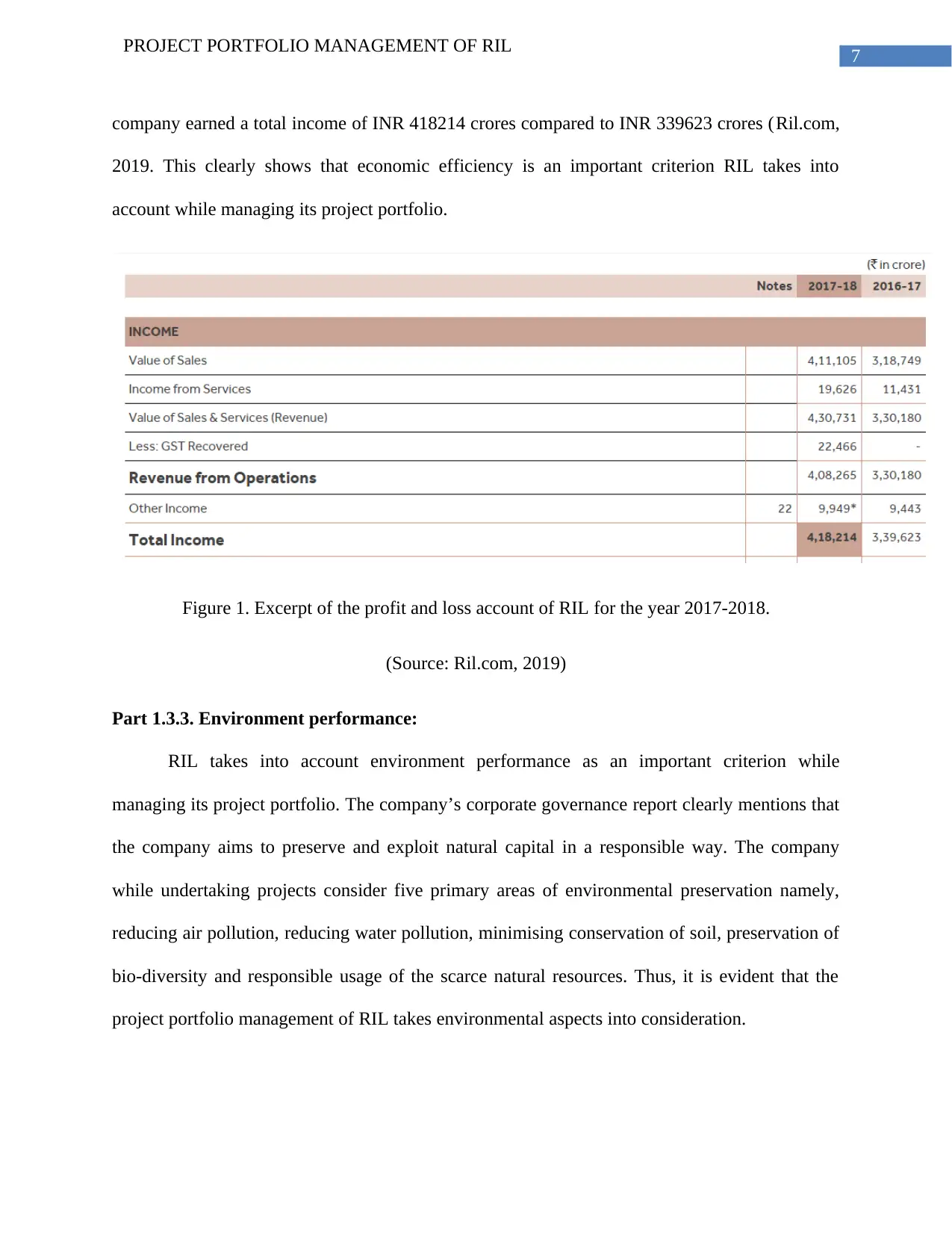
7
PROJECT PORTFOLIO MANAGEMENT OF RIL
company earned a total income of INR 418214 crores compared to INR 339623 crores (Ril.com,
2019. This clearly shows that economic efficiency is an important criterion RIL takes into
account while managing its project portfolio.
Figure 1. Excerpt of the profit and loss account of RIL for the year 2017-2018.
(Source: Ril.com, 2019)
Part 1.3.3. Environment performance:
RIL takes into account environment performance as an important criterion while
managing its project portfolio. The company’s corporate governance report clearly mentions that
the company aims to preserve and exploit natural capital in a responsible way. The company
while undertaking projects consider five primary areas of environmental preservation namely,
reducing air pollution, reducing water pollution, minimising conservation of soil, preservation of
bio-diversity and responsible usage of the scarce natural resources. Thus, it is evident that the
project portfolio management of RIL takes environmental aspects into consideration.
PROJECT PORTFOLIO MANAGEMENT OF RIL
company earned a total income of INR 418214 crores compared to INR 339623 crores (Ril.com,
2019. This clearly shows that economic efficiency is an important criterion RIL takes into
account while managing its project portfolio.
Figure 1. Excerpt of the profit and loss account of RIL for the year 2017-2018.
(Source: Ril.com, 2019)
Part 1.3.3. Environment performance:
RIL takes into account environment performance as an important criterion while
managing its project portfolio. The company’s corporate governance report clearly mentions that
the company aims to preserve and exploit natural capital in a responsible way. The company
while undertaking projects consider five primary areas of environmental preservation namely,
reducing air pollution, reducing water pollution, minimising conservation of soil, preservation of
bio-diversity and responsible usage of the scarce natural resources. Thus, it is evident that the
project portfolio management of RIL takes environmental aspects into consideration.
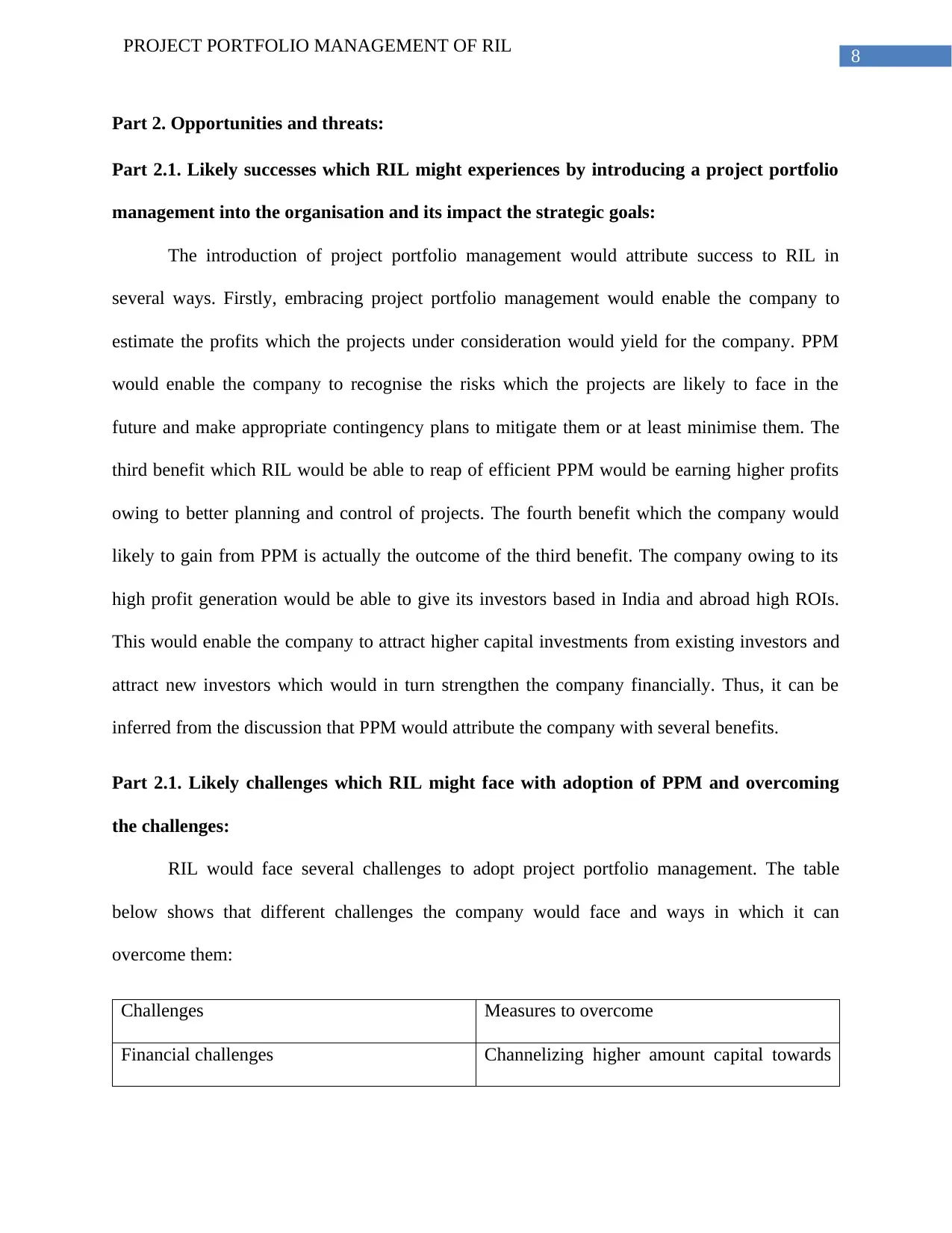
8
PROJECT PORTFOLIO MANAGEMENT OF RIL
Part 2. Opportunities and threats:
Part 2.1. Likely successes which RIL might experiences by introducing a project portfolio
management into the organisation and its impact the strategic goals:
The introduction of project portfolio management would attribute success to RIL in
several ways. Firstly, embracing project portfolio management would enable the company to
estimate the profits which the projects under consideration would yield for the company. PPM
would enable the company to recognise the risks which the projects are likely to face in the
future and make appropriate contingency plans to mitigate them or at least minimise them. The
third benefit which RIL would be able to reap of efficient PPM would be earning higher profits
owing to better planning and control of projects. The fourth benefit which the company would
likely to gain from PPM is actually the outcome of the third benefit. The company owing to its
high profit generation would be able to give its investors based in India and abroad high ROIs.
This would enable the company to attract higher capital investments from existing investors and
attract new investors which would in turn strengthen the company financially. Thus, it can be
inferred from the discussion that PPM would attribute the company with several benefits.
Part 2.1. Likely challenges which RIL might face with adoption of PPM and overcoming
the challenges:
RIL would face several challenges to adopt project portfolio management. The table
below shows that different challenges the company would face and ways in which it can
overcome them:
Challenges Measures to overcome
Financial challenges Channelizing higher amount capital towards
PROJECT PORTFOLIO MANAGEMENT OF RIL
Part 2. Opportunities and threats:
Part 2.1. Likely successes which RIL might experiences by introducing a project portfolio
management into the organisation and its impact the strategic goals:
The introduction of project portfolio management would attribute success to RIL in
several ways. Firstly, embracing project portfolio management would enable the company to
estimate the profits which the projects under consideration would yield for the company. PPM
would enable the company to recognise the risks which the projects are likely to face in the
future and make appropriate contingency plans to mitigate them or at least minimise them. The
third benefit which RIL would be able to reap of efficient PPM would be earning higher profits
owing to better planning and control of projects. The fourth benefit which the company would
likely to gain from PPM is actually the outcome of the third benefit. The company owing to its
high profit generation would be able to give its investors based in India and abroad high ROIs.
This would enable the company to attract higher capital investments from existing investors and
attract new investors which would in turn strengthen the company financially. Thus, it can be
inferred from the discussion that PPM would attribute the company with several benefits.
Part 2.1. Likely challenges which RIL might face with adoption of PPM and overcoming
the challenges:
RIL would face several challenges to adopt project portfolio management. The table
below shows that different challenges the company would face and ways in which it can
overcome them:
Challenges Measures to overcome
Financial challenges Channelizing higher amount capital towards
⊘ This is a preview!⊘
Do you want full access?
Subscribe today to unlock all pages.

Trusted by 1+ million students worldwide
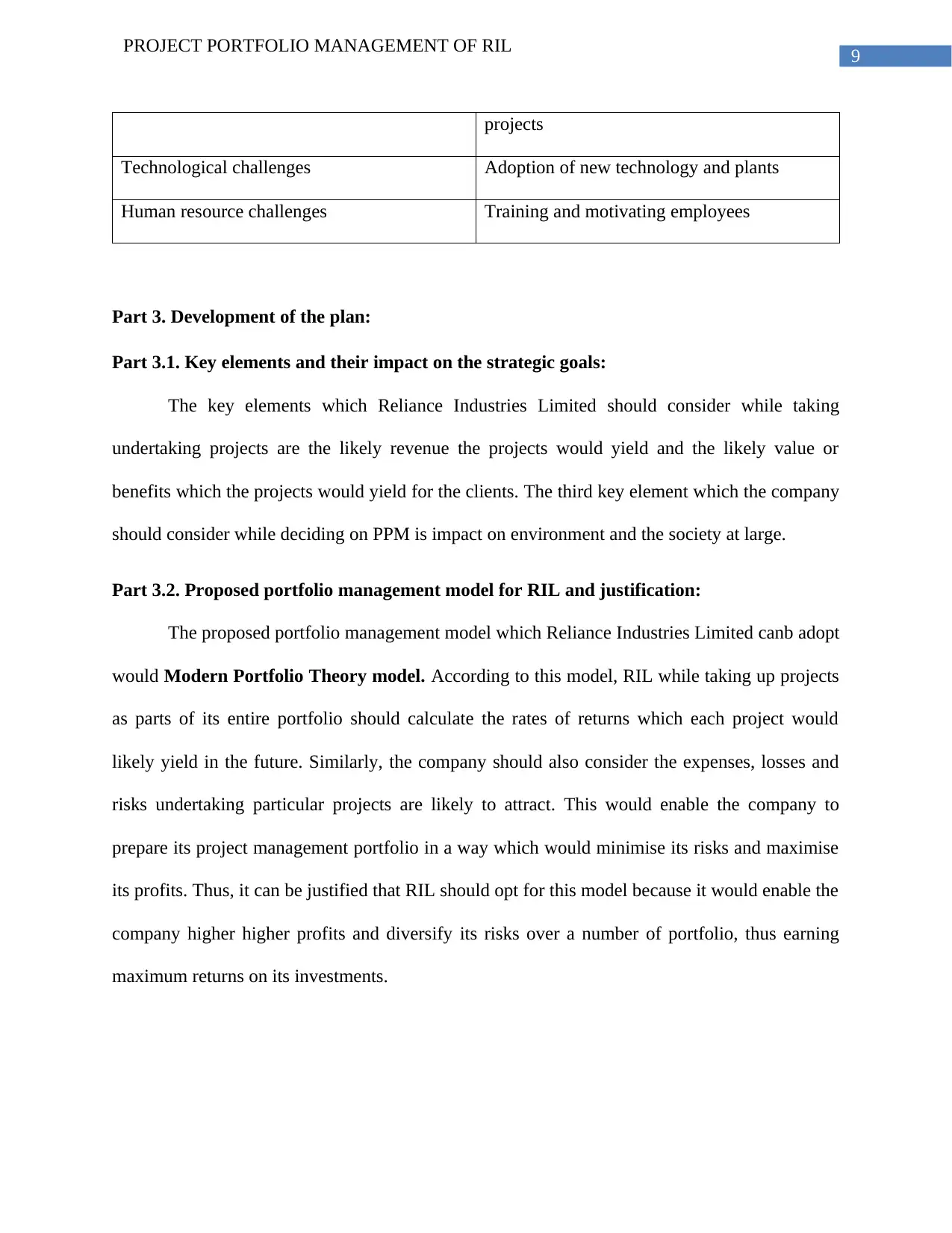
9
PROJECT PORTFOLIO MANAGEMENT OF RIL
projects
Technological challenges Adoption of new technology and plants
Human resource challenges Training and motivating employees
Part 3. Development of the plan:
Part 3.1. Key elements and their impact on the strategic goals:
The key elements which Reliance Industries Limited should consider while taking
undertaking projects are the likely revenue the projects would yield and the likely value or
benefits which the projects would yield for the clients. The third key element which the company
should consider while deciding on PPM is impact on environment and the society at large.
Part 3.2. Proposed portfolio management model for RIL and justification:
The proposed portfolio management model which Reliance Industries Limited canb adopt
would Modern Portfolio Theory model. According to this model, RIL while taking up projects
as parts of its entire portfolio should calculate the rates of returns which each project would
likely yield in the future. Similarly, the company should also consider the expenses, losses and
risks undertaking particular projects are likely to attract. This would enable the company to
prepare its project management portfolio in a way which would minimise its risks and maximise
its profits. Thus, it can be justified that RIL should opt for this model because it would enable the
company higher higher profits and diversify its risks over a number of portfolio, thus earning
maximum returns on its investments.
PROJECT PORTFOLIO MANAGEMENT OF RIL
projects
Technological challenges Adoption of new technology and plants
Human resource challenges Training and motivating employees
Part 3. Development of the plan:
Part 3.1. Key elements and their impact on the strategic goals:
The key elements which Reliance Industries Limited should consider while taking
undertaking projects are the likely revenue the projects would yield and the likely value or
benefits which the projects would yield for the clients. The third key element which the company
should consider while deciding on PPM is impact on environment and the society at large.
Part 3.2. Proposed portfolio management model for RIL and justification:
The proposed portfolio management model which Reliance Industries Limited canb adopt
would Modern Portfolio Theory model. According to this model, RIL while taking up projects
as parts of its entire portfolio should calculate the rates of returns which each project would
likely yield in the future. Similarly, the company should also consider the expenses, losses and
risks undertaking particular projects are likely to attract. This would enable the company to
prepare its project management portfolio in a way which would minimise its risks and maximise
its profits. Thus, it can be justified that RIL should opt for this model because it would enable the
company higher higher profits and diversify its risks over a number of portfolio, thus earning
maximum returns on its investments.
Paraphrase This Document
Need a fresh take? Get an instant paraphrase of this document with our AI Paraphraser
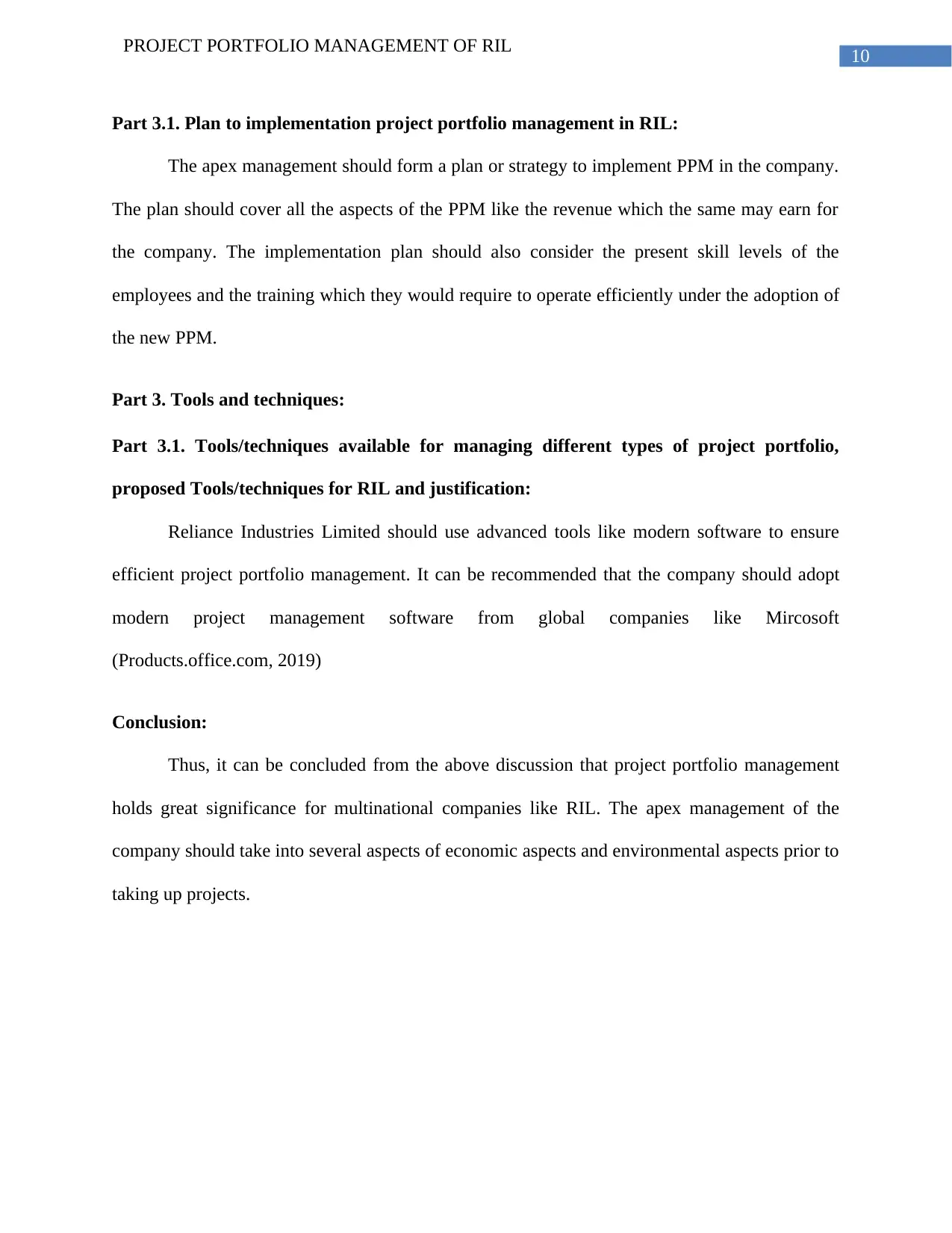
10
PROJECT PORTFOLIO MANAGEMENT OF RIL
Part 3.1. Plan to implementation project portfolio management in RIL:
The apex management should form a plan or strategy to implement PPM in the company.
The plan should cover all the aspects of the PPM like the revenue which the same may earn for
the company. The implementation plan should also consider the present skill levels of the
employees and the training which they would require to operate efficiently under the adoption of
the new PPM.
Part 3. Tools and techniques:
Part 3.1. Tools/techniques available for managing different types of project portfolio,
proposed Tools/techniques for RIL and justification:
Reliance Industries Limited should use advanced tools like modern software to ensure
efficient project portfolio management. It can be recommended that the company should adopt
modern project management software from global companies like Mircosoft
(Products.office.com, 2019)
Conclusion:
Thus, it can be concluded from the above discussion that project portfolio management
holds great significance for multinational companies like RIL. The apex management of the
company should take into several aspects of economic aspects and environmental aspects prior to
taking up projects.
PROJECT PORTFOLIO MANAGEMENT OF RIL
Part 3.1. Plan to implementation project portfolio management in RIL:
The apex management should form a plan or strategy to implement PPM in the company.
The plan should cover all the aspects of the PPM like the revenue which the same may earn for
the company. The implementation plan should also consider the present skill levels of the
employees and the training which they would require to operate efficiently under the adoption of
the new PPM.
Part 3. Tools and techniques:
Part 3.1. Tools/techniques available for managing different types of project portfolio,
proposed Tools/techniques for RIL and justification:
Reliance Industries Limited should use advanced tools like modern software to ensure
efficient project portfolio management. It can be recommended that the company should adopt
modern project management software from global companies like Mircosoft
(Products.office.com, 2019)
Conclusion:
Thus, it can be concluded from the above discussion that project portfolio management
holds great significance for multinational companies like RIL. The apex management of the
company should take into several aspects of economic aspects and environmental aspects prior to
taking up projects.
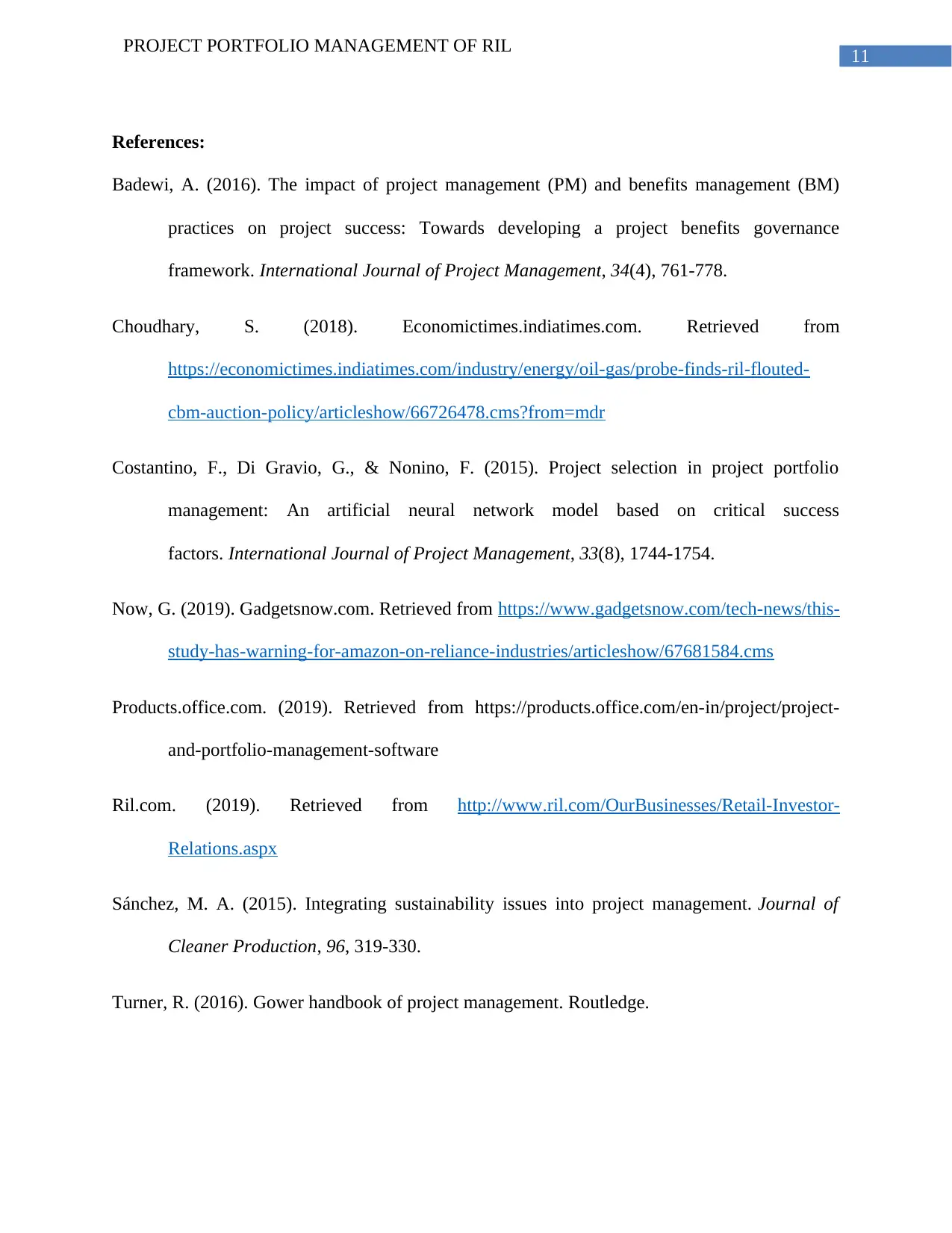
11
PROJECT PORTFOLIO MANAGEMENT OF RIL
References:
Badewi, A. (2016). The impact of project management (PM) and benefits management (BM)
practices on project success: Towards developing a project benefits governance
framework. International Journal of Project Management, 34(4), 761-778.
Choudhary, S. (2018). Economictimes.indiatimes.com. Retrieved from
https://economictimes.indiatimes.com/industry/energy/oil-gas/probe-finds-ril-flouted-
cbm-auction-policy/articleshow/66726478.cms?from=mdr
Costantino, F., Di Gravio, G., & Nonino, F. (2015). Project selection in project portfolio
management: An artificial neural network model based on critical success
factors. International Journal of Project Management, 33(8), 1744-1754.
Now, G. (2019). Gadgetsnow.com. Retrieved from https://www.gadgetsnow.com/tech-news/this-
study-has-warning-for-amazon-on-reliance-industries/articleshow/67681584.cms
Products.office.com. (2019). Retrieved from https://products.office.com/en-in/project/project-
and-portfolio-management-software
Ril.com. (2019). Retrieved from http://www.ril.com/OurBusinesses/Retail-Investor-
Relations.aspx
Sánchez, M. A. (2015). Integrating sustainability issues into project management. Journal of
Cleaner Production, 96, 319-330.
Turner, R. (2016). Gower handbook of project management. Routledge.
PROJECT PORTFOLIO MANAGEMENT OF RIL
References:
Badewi, A. (2016). The impact of project management (PM) and benefits management (BM)
practices on project success: Towards developing a project benefits governance
framework. International Journal of Project Management, 34(4), 761-778.
Choudhary, S. (2018). Economictimes.indiatimes.com. Retrieved from
https://economictimes.indiatimes.com/industry/energy/oil-gas/probe-finds-ril-flouted-
cbm-auction-policy/articleshow/66726478.cms?from=mdr
Costantino, F., Di Gravio, G., & Nonino, F. (2015). Project selection in project portfolio
management: An artificial neural network model based on critical success
factors. International Journal of Project Management, 33(8), 1744-1754.
Now, G. (2019). Gadgetsnow.com. Retrieved from https://www.gadgetsnow.com/tech-news/this-
study-has-warning-for-amazon-on-reliance-industries/articleshow/67681584.cms
Products.office.com. (2019). Retrieved from https://products.office.com/en-in/project/project-
and-portfolio-management-software
Ril.com. (2019). Retrieved from http://www.ril.com/OurBusinesses/Retail-Investor-
Relations.aspx
Sánchez, M. A. (2015). Integrating sustainability issues into project management. Journal of
Cleaner Production, 96, 319-330.
Turner, R. (2016). Gower handbook of project management. Routledge.
⊘ This is a preview!⊘
Do you want full access?
Subscribe today to unlock all pages.

Trusted by 1+ million students worldwide
1 out of 13
Related Documents
Your All-in-One AI-Powered Toolkit for Academic Success.
+13062052269
info@desklib.com
Available 24*7 on WhatsApp / Email
![[object Object]](/_next/static/media/star-bottom.7253800d.svg)
Unlock your academic potential
Copyright © 2020–2025 A2Z Services. All Rights Reserved. Developed and managed by ZUCOL.




